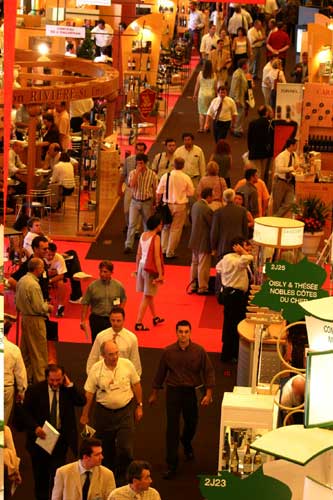Tasting size notes from Vinexpo
 What do you get when you blend 2,500 exhibitors from 47 countries with record-breaking summer heat in Bordeaux? Why, this year’s Vinexpo, the biennial wine trade show, with 48,000 visitors who came to sample the latest vintages, schmooze, and do deals.
What do you get when you blend 2,500 exhibitors from 47 countries with record-breaking summer heat in Bordeaux? Why, this year’s Vinexpo, the biennial wine trade show, with 48,000 visitors who came to sample the latest vintages, schmooze, and do deals.
Vinexpo illustrated three of the main trends in the wine world right now: tensions between France and America, increasing globalization of production, and rising quality. To give you a flavor for what it was like at the event, I have excerpted some tasting size pours from my notes…
Cuvée Libération
Everyone attends Vinexpo, even the guys who sell barrels. Oak barrels are all the rage among quality wine producers and are a major cost (particularly for those who buy French oak denominated in euros). I lunched with a barrel salesman responsible for North Africa and the Middle East, an area that has been gripped by wine fever. Hmm, Arabic wine? It takes all kinds. Indeed, good wines now come from such places as Morocco, Tunisia, and Lebanon. With even a conservative country such as Syria planting vines (for wines, not for raisins, he assured me), the barrel salesman would not be surprised if the Americans planted vines in Iraq. One wonders what they would call it—Cuvée Liberation 2003?
Oh, Canada!?
“Vines love it here” the enormous sign at the Canada stand exclaimed. I guess that beat out the slogan “beyond icewine,” Canada’s best-known viticultural product. Canada remains much more of a wine consuming country than a producer, but the small growing areas are producing wines from the “noble varietals” of France. With more countries of the north producing wine, such as England, might global warming make these the vineyards of the future? Time to buy that vineyard property in Norway?
The brave face
During the week of Vinexpo, retail sales figures for French wines in the US showed a decline of 25% over the same four-week period one year earlier. Awe and incredulity were the reactions I encountered from industry participants on both sides of the Atlantic. The diplomatic tensions between France and the US have led to American boycotts of French wine. But the general sentiment from the French side is that “time heals all wounds.” The thaw seen earlier in the month at the highest level was also on display here in Bordeaux as the French PM Jean-Pierre Raffarin pressed the flesh of the US ambassador.
Swirl and spit
What if you have a party and nobody comes? Or at least the guest of honor? Such was the case in March at the Bordeaux annual barrel tasting when Robert Parker, world’s foremost wine critic, decided not to attend. That was the nail in the coffin for the 2002 vintage, which saw prices tumble after already being pressured by economic malaise and bad weather last August. As your stalwart correspondent, I braved the crowds of adults with purple teeth making gurgling noises to taste through the top chateaux of the vintage and found it a solid one. Yum. Swirl and spit accurately.
Red hot Chili
Chile is hot. The Chileans staked out a large corner of the main hall and their stands were buzzing. Buoyed by the prospect of a Free Trade Arrangement with the US as well as an influx of investment from Europe and North America, Chile is hoping to increase exports even more. But the leading Chilean producer Concha y Toro decided to forego the main exhibition hall for the sanctity of an outdoor private tent in exclusive the “Club des Marques” area. However, with temperatures over 100 degrees (40 Celsius) it was the smaller producers in the air conditioning who had the last laugh as more than one Concha y Toro representative sought relief inside.
Greenback blues?
As if the diplomatic crisis weren’t enough for the French, the euro has strengthened significantly against the dollar for a year or more. This makes the prospect of imports to the US more expensive-for all European wines. But the same currency move makes US exports to Europe cheaper. Are the US producers licking their lips? Yes and no. With only 15% of production exported, and many boutique producers who have small production and high demand, the US remains a net importer of wine. So what motivates US producers to attend international trade shows and sell their wares overseas? According to Margaret Duckhorn of Duckhorn Vineyards, “We make a world-class wine and we want to sell it to the world.”
Just eat it
The greenback’s weakness has cramped the European producers, but will they be the only ones to eat the currency swing, if at all? Many, particularly those with strong sales, steadfastly refused to lower their price out the winery door. But US importers, who stress the importance of retail price points, are certainly giving producers the squeeze. While the threat of unsold stock makes importers wary, they may have been protected against the currency move. According to a leading US retailer, if the cost to them goes up, then the price goes up, simple as that. So that leaves the consumer likely to foot the bill when the dollar weakens. How about giving us something back when the currency strengthens? Slim hope…



